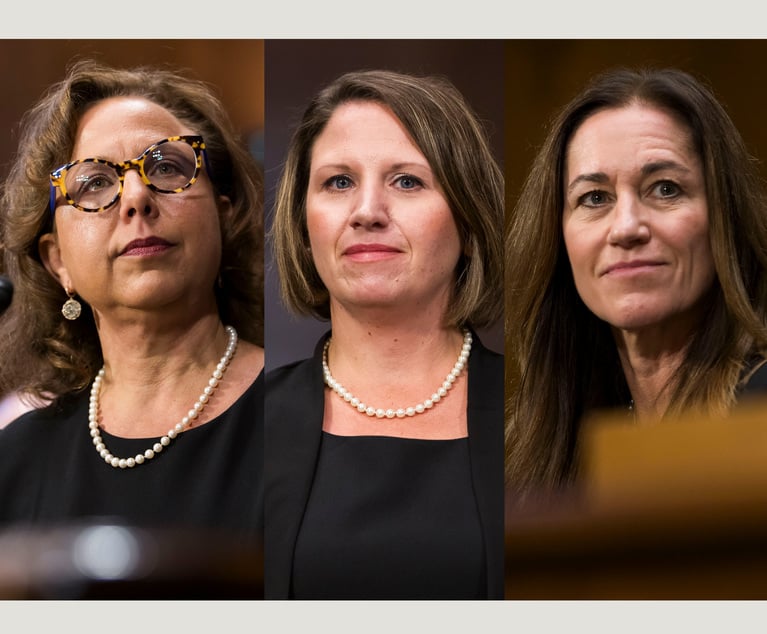Coming Face-to-Face With Facial Recognition Technology
Facial technology identifies an image of a face by breaking down the depicted face into several characteristics (e.g., the relative position, shape, contours and size of facial features) and then searching a database of pre-identified faces for matching characteristics.
July 29, 2019 at 01:05 PM
8 minute read
 Jeffrey N. Rosenthal, left, and Huaou Yan, right, of Blank Rome.
Jeffrey N. Rosenthal, left, and Huaou Yan, right, of Blank Rome.
Popularized by Steven Spielberg's 2002 film “Minority Report”—which depicts a bleak future where a special police unit detects targets by video and arrests criminals before they commit their crimes—facial recognition technology allows computers to analyze an image or video of a human face to identify the person. Today, look at any modern iPhone with Face ID capabilities and you have just experienced such technology for yourself.
On May 14, San Francisco became the first U.S. city to ban the use of facial recognition technology by police and other local government agencies. A month later, on June 27, Somerville, Massachusetts, became the second. And San Francisco's Bay Area neighbors, Oakland and Berkeley, are currently considering similar bans.
While these bans are more symbolic than immediately impactful (neither city had used facial recognition prior), the bans are likely a response to a real and prominent concern: how can facial recognition technology be used without compromising civil liberties?
What Is Facial Recognition Technology?
Facial technology identifies an image of a face by breaking down the depicted face into several characteristics (e.g., the relative position, shape, contours and size of facial features) and then searching a database of pre-identified faces for matching characteristics.
The speed at which a computer can perform this function—i.e., comparing an image of a face with millions, or potentially billions, of other faces—allows identification from an image alone, where previously such identification would have been impossible as a practical matter. Indeed, the latest facial recognition technology can even operate in real-time, identifying people as they appear on live video.
The combination of networks of surveillance cameras and databases of pre-identified photos (like state driver's licenses) has brought Orwellian concerns regarding facial recognition technology out of the realm of science fiction and into the realm of the possible.
Is Big Brother Watching?
Although no governmental actor in the United States is known to currently be using facial recognition technology to conduct real-time surveillance, many are using such technology in some capacity; widespread usage by the government is rapidly becoming unavoidable.
A year-long investigation conducted in 2016 by Georgetown's Center on Privacy and Technology estimated that over 117 million American adults—or nearly “one in two American adults”—was already “in a law enforcement face recognition network.”
Just last year, Maryland police used facial recognition technology to identify the suspect in the high-profile mass shooting at the Capital Gazette in Annapolis. But the use of facial recognition technology goes well beyond a few high-profile cases.
In a June 9, op-ed in The New York Times, James O'Neill, the New York City police commissioner, shared that in 2018, NYPD detectives submitted 7,024 requests to the NYPD's Facial Identification Section (which currently only searches its own database of arrest photos). Those 7,024 searches returned matches in 1,851 cases and ultimately led to 998 arrests. Other major cities that employ facial recognition technology in some form include: Las Vegas; Orlando, Florida; San Jose, California; San Diego; Boston; Detroit; Chicago; and Durham, North Carolina.
At the federal level, the FBI has long used facial recognition technology. According to a recent Government Accountability Office report, the FBI has run over 390,000 searches using facial recognition technology through a database it compiled containing over 640 million photographs. Meanwhile, since at least 2015, U.S. Customs and Border Protection has been testing and deploying facial recognition technology in airports and other ports of entry as part of an initiative to biometrically verify all travelers entering and exiting the country. And earlier this month, documents obtained by Georgetown Law's Center on Privacy and Technology revealed that U.S. Immigration and Customs Enforcement requested access to use facial recognition technology to scan driver's license photo databases from at least three states that offer licenses to undocumented immigrants (Utah, Vermont and Washington). Just a few days later, the American Civil Liberties Union of Massachusetts sued the Massachusetts Department of Transportation to obtain records regarding the agency's sharing of access to Massachusetts' driver's license database for facial recognition purposes.
'O Brave New World That Has Such People In't.'
The benefits of facial recognition technology are obvious: used properly, it can be an incredibly powerful crime-fighting tool. Many, however, are deeply concerned about the concomitant dangers.
First, facial recognition technology remains far from 100% accurate. And a false positive—where the system identifies the wrong person—may result in the investigation, prosecution, and conviction of innocent people.
Take, for example, the case of State of Florida v. Lynch. In September 2015, two undercover detectives purchased $50 of crack cocaine from an African American man on the street in Jacksonville, Florida. One of the detectives surreptitiously took several photos of the suspect with an old Tracfone from Walmart, while pretending to be on a call. Because neither detective recognized the suspect, they ran one of the photos through a facial recognition system that compared the image with more than 33 million driver's license and law enforcement matches. The facial recognition system returned five possible matches but rated the matches “one-star,” the lowest confidence rating. Willie Allen Lynch was the first match. Even though the system returned five possible matches, the analyst—who admitted she did not understand how the system worked—only passed along Lynch's photograph and information to the detectives. The detectives never looked at the photos of the other four matches. Based on this identification, Lynch was ultimately convicted and sentenced to eight years of incarceration.
More troublingly, several studies suggest current facial recognition technology is less accurate at identifying people of color, and thus, that the harm of misidentification will likely fall disproportionately on this population. A 2018 study by a researcher at MIT's Media Lab and a scientist at Microsoft Research found facial recognition systems from IBM and Microsoft misidentified the gender of images of light-skinned males in a test data set only 1% of the time but misidentified the gender of images of darker-skinned females up to 34.7% of the time. A subsequent study released this year found Amazon's facial recognition system, Rekognition, did not misidentify the gender of any light-skinned males in the test data set but misidentified the gender of darker-skinned females 31.37% of the time.
Even if facial recognition technology were 100% accurate, the existence of technology that enables the government (or any user) to easily monitor, identify and track those in public is deeply concerning to some.
One can easily imagine the potential for abuse of facial recognition technology. For example, government actors could use it to target perceived political opponents and chill speech. In the United States, the Baltimore Police Department used facial recognition technology during protests following the death of Freddie Gray, who died in police custody, to identify protesters with outstanding warrants and arrest them from the crowd. And in China, the government is using facial recognition technology on a massive, nationwide scale to systematically track and control a specific minority group, the Uighurs.
Even setting aside the more egregious potential abuses, commentators have observed the fundamental intrusiveness of surveillance cameras capturing and scanning faces in public. Presently, government actors generally do not need a warrant, probable cause or even reasonable suspicion to employ facial recognition technology. To the extent our society believes in some right to privacy over public movements—i.e., a right to go about one's day-to-day life in public with some degree of anonymity—the unfettered ability for the government to identify and track people in public is unavoidably inimical to that right.
Facial recognition technology is not likely to go away. And the national debate on the parameters of its use is just beginning. Soon we may all have to face the ubiquitous presence of facial recognition technology.
Jeffrey N. Rosenthal is a partner in Blank Rome's Philadelphia office. He concentrates his complex corporate litigation practice on consumer and privacy class action defense, and regularly publishes and presents on class action trends, attorney ethics and social media law. Contact him at [email protected].
Huaou Yan is an associate in the firm's Philadelphia office. He concentrates his practice on complex, commercial litigation and white-collar investigations. Contact him at [email protected].
This content has been archived. It is available through our partners, LexisNexis® and Bloomberg Law.
To view this content, please continue to their sites.
Not a Lexis Subscriber?
Subscribe Now
Not a Bloomberg Law Subscriber?
Subscribe Now
NOT FOR REPRINT
© 2025 ALM Global, LLC, All Rights Reserved. Request academic re-use from www.copyright.com. All other uses, submit a request to [email protected]. For more information visit Asset & Logo Licensing.
You Might Like
View All
Pa. Federal District Courts Reach Full Complement Following Latest Confirmation

The Defense Bar Is Feeling the Strain: Busy Med Mal Trial Schedules Might Be Phila.'s 'New Normal'
7 minute read
Federal Judge Allows Elderly Woman's Consumer Protection Suit to Proceed Against Citizens Bank
5 minute read
Judge Leaves Statute of Limitations Question in Injury Crash Suit for a Jury
4 minute readTrending Stories
- 1CFPB Labor Union Files Twin Lawsuits Seeking to Prevent Agency's Closure
- 2Crypto Crime Down, Hacks Up: Lawyers Warned of 2025 Security Shake-Up
- 3Atlanta Calling: National Law Firms Flock to a ‘Hotbed for Talented Lawyers’
- 4Privacy Suit Targets Education Department Over Disclosure of Student Financial Data to DOGE
- 5Colwell Law Group Founder Has Died in Skiing Accident
Who Got The Work
J. Brugh Lower of Gibbons has entered an appearance for industrial equipment supplier Devco Corporation in a pending trademark infringement lawsuit. The suit, accusing the defendant of selling knock-off Graco products, was filed Dec. 18 in New Jersey District Court by Rivkin Radler on behalf of Graco Inc. and Graco Minnesota. The case, assigned to U.S. District Judge Zahid N. Quraishi, is 3:24-cv-11294, Graco Inc. et al v. Devco Corporation.
Who Got The Work
Rebecca Maller-Stein and Kent A. Yalowitz of Arnold & Porter Kaye Scholer have entered their appearances for Hanaco Venture Capital and its executives, Lior Prosor and David Frankel, in a pending securities lawsuit. The action, filed on Dec. 24 in New York Southern District Court by Zell, Aron & Co. on behalf of Goldeneye Advisors, accuses the defendants of negligently and fraudulently managing the plaintiff's $1 million investment. The case, assigned to U.S. District Judge Vernon S. Broderick, is 1:24-cv-09918, Goldeneye Advisors, LLC v. Hanaco Venture Capital, Ltd. et al.
Who Got The Work
Attorneys from A&O Shearman has stepped in as defense counsel for Toronto-Dominion Bank and other defendants in a pending securities class action. The suit, filed Dec. 11 in New York Southern District Court by Bleichmar Fonti & Auld, accuses the defendants of concealing the bank's 'pervasive' deficiencies in regards to its compliance with the Bank Secrecy Act and the quality of its anti-money laundering controls. The case, assigned to U.S. District Judge Arun Subramanian, is 1:24-cv-09445, Gonzalez v. The Toronto-Dominion Bank et al.
Who Got The Work
Crown Castle International, a Pennsylvania company providing shared communications infrastructure, has turned to Luke D. Wolf of Gordon Rees Scully Mansukhani to fend off a pending breach-of-contract lawsuit. The court action, filed Nov. 25 in Michigan Eastern District Court by Hooper Hathaway PC on behalf of The Town Residences LLC, accuses Crown Castle of failing to transfer approximately $30,000 in utility payments from T-Mobile in breach of a roof-top lease and assignment agreement. The case, assigned to U.S. District Judge Susan K. Declercq, is 2:24-cv-13131, The Town Residences LLC v. T-Mobile US, Inc. et al.
Who Got The Work
Wilfred P. Coronato and Daniel M. Schwartz of McCarter & English have stepped in as defense counsel to Electrolux Home Products Inc. in a pending product liability lawsuit. The court action, filed Nov. 26 in New York Eastern District Court by Poulos Lopiccolo PC and Nagel Rice LLP on behalf of David Stern, alleges that the defendant's refrigerators’ drawers and shelving repeatedly break and fall apart within months after purchase. The case, assigned to U.S. District Judge Joan M. Azrack, is 2:24-cv-08204, Stern v. Electrolux Home Products, Inc.
Featured Firms
Law Offices of Gary Martin Hays & Associates, P.C.
(470) 294-1674
Law Offices of Mark E. Salomone
(857) 444-6468
Smith & Hassler
(713) 739-1250





